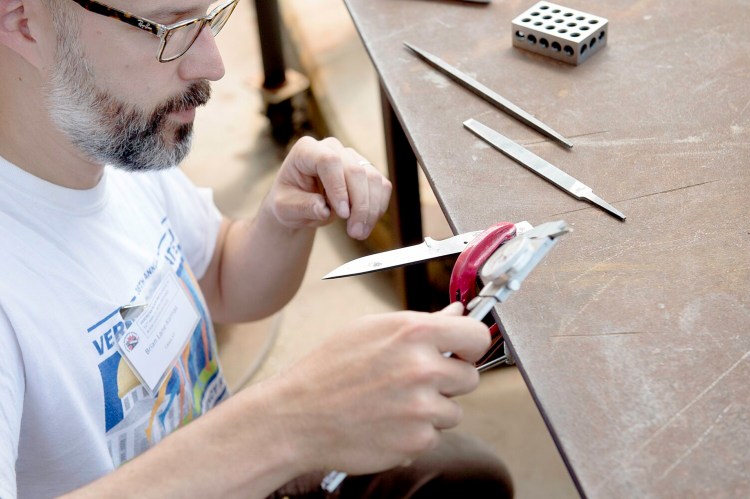AUBURN — When Nick Rossi, resident bladesmith at the New England School of Metalwork in Auburn, first tried his hand at the forge, he didn’t have much instruction.
“When I learned how to do this, there were a couple books, and they all were bad,” Rossi said. But, after a multi-year trial by fire, Rossi mastered his craft, and now teaches as an instructor at the school.
“People progress with the proper lessons. I’ve seen people do what took me eight years in two or three, with all the proper information and the right knowledge. It makes me really, really happy to see them avoid all of that struggle,” Rossi said.
At the New England Bladesmith Symposium held at the New England School of Metalwork in Auburn on Saturday, Rossi said the goal was teaching experienced and inexperienced smiths new tricks of the trade.
The event, put on in conjunction with the American Bladesmith Society, the largest organization dedicated to forging blades in the world, featured talks and demonstrations from experts Rossi called true masters of the craft.
“They’re basically showing us all of their secrets. The secret is that there are no secrets. This community wants to share, and wants everyone to get better,” said Rossi.
During the symposium, Leo Potter, 21, of Massachusetts wielded a blade he crafted during a class at the school. The sword was modeled after a basic army blade that would have been used by a medieval cavalry or infantry,
“It’s a pretty basic sword, but it shows the fundamentals of sword-making. It really is a great-way to get started. It doesn’t have all the insane embellishment, but it has the more basic things that are harder to grasp,” said Potter.
Potter said the sword was made using traditional geometric patterns; the same way it would have been forged centuries ago. Back then, they didn’t measure the steel. The crafting of the blade was based off of circles, squares and geometric shapes.
“People don’t design things like that anymore; it’s kind of a lost art,” said Potter.
Potter said he picked up a hammer and a piece of steel three years ago and didn’t want to stop. He decided to attend NESM as a way to get as close to a traditional education in bladesmithing and blacksmithing as he could.
“The people that run the place are really helpful, and they have great instructors, and every time I leave here, whether it’s from an event or for a class, I learn something new,” said Potter.
Rossi thinks bladesmithing has become popular, thanks to Youtube videos and popular television shows like “Forged in the Fire.” But events like the symposium help bring together smiths and keep the craft alive, and relevant.
“We don’t want this to be a flash in the pan, we want this to continue to be successful,” said Rossi.
Send questions/comments to the editors.


